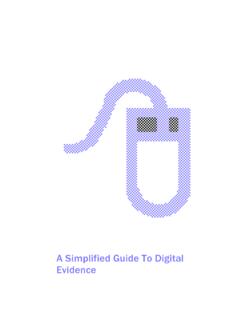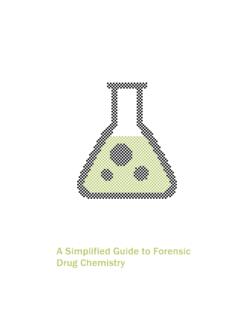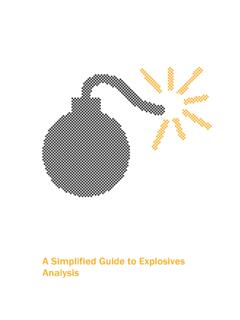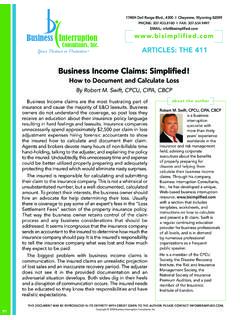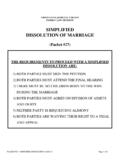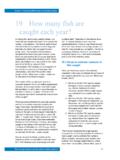Transcription of A Simplified Guide To Bloodstain Pattern Analysis
1 A Simplified Guide To Bloodstain Pattern Analysis Introduction Because blood behaves according to certain scientific principles, trained Bloodstain Pattern analysts can examine the blood evidence left behind and draw conclusions as to how the blood may have been shed. From what may appear to be a random distribution of bloodstains at a crime scene, analysts can categorize the stains by gathering information from spatter patterns , transfers, voids and other marks that assist investigators in recreating the sequence of events that occurred after bloodshed.
2 This form of physical evidence requires the analyst to recognize and interpret patterns to determine how those patterns were created. (Courtesy of NFSTC) Bloodstain Pattern Analysis (BPA) is the interpretation of bloodstains at a crime scene in order to recreate the actions that caused the bloodshed. Analysts examine the size, shape, distribution and location of the bloodstains to form opinions about what did or did not happen. BPA uses principles of biology (behavior of blood), physics (cohesion, capillary action and velocity) and mathematics (geometry, distance, and angle) to assist investigators in answering questions such as: Where did the blood come from?
3 What caused the wounds? From what direction was the victim wounded? How were the victim(s) and perpetrator(s) positioned? What movements were made after the bloodshed? How many potential perpetrators were present? Does the Bloodstain evidence support or refute witness statements? Because blood behaves according to certain scientific principles, trained Bloodstain Pattern analysts can examine the blood evidence left behind [and draw conclusions as to how the blood may have been shed].
4 From what may appear to be a random distribution of bloodstains at a crime scene, analysts can categorize the stains by gathering information from spatter patterns , transfers, voids and other marks that assist investigators in recreating the sequence of events that occurred after bloodshed. This form of physical evidence requires the analyst to recognize and interpret patterns to determine how those patterns were created. BPA provides information not only about what happened, but just as importantly, what could not have happened.
5 This information can assist the investigator in reconstructing the crime, corroborating statements from witnesses, and including or excluding potential perpetrators from the investigation. Principles of Bloodstain Pattern Analysis To understand how analysts interpret bloodstains, one must first understand the basic properties of blood. Blood contains both liquid (plasma and serum) and solids (red blood cells, white blood cells, platelets and proteins). Blood is in a liquid state when inside the body, and when it exits the body, it does so as a liquid.
6 But as anyone who has had a cut or a scrape knows, it doesn t remain a liquid for long. Except for people with hemophilia, blood will begin to clot within a few minutes, forming a dark, shiny gel- like substance that grows more solid as time progresses. The presence of blood clots in bloodstains can indicate that the attack was prolonged, or that the victim was bleeding for some time after the injury occurred. Blood can leave the body in many different ways, depending on the type of injury inflicted.
7 It can flow, drip, spray, spurt, gush or just ooze from wounds. Types of Stains Bloodstains are classified into three basic types: passive stains, transfer stains and projected or impact stains. Passive stains include drops, flows and pools, and typically result from gravity acting on an injured body. Transfer stains result from objects coming into contact with existing bloodstains and leaving wipes, swipes or Pattern transfers behind such as a bloody shoe print or a smear from a body being dragged.
8 Impact stains result from blood projecting through the air and are usually seen as spatter, but may also include gushes, splashes and arterial spurts. Passive Bloodstain on a wooden floorboard. (Courtesy of John Black, Ron Smith & Associates) Transfer Pattern made by a bloody hand. (Courtesy of John Black, Ron Smith & Associates) Blood spatter is categorized as impact spatter (created when a force is applied to a liquid blood source) or projection spatter (caused by arterial spurting, expirated spray or spatter cast off an object).
9 The characteristics of blood spatter depend on the speed at which the blood leaves the body and the type of force applied to the blood source. Gunshot spatter - includes both forward spatter from the exit wound and back spatter from the entrance wound. Gunshot spatter will vary depending on the caliber of the gun, where the victim is struck, whether the bullet exits the body, distance between the victim and the gun and location of the victim relative to walls, floors and objects.
10 Typically, forward spatter is a fine mist and back spatter is larger and fewer drops. Back spatter from a gunshot wound on a steering wheel. (Courtesy of John Black, Ron Smith & Associates) Cast- off - results when an object swung in an arc flings blood onto nearby surfaces. This occurs when an assailant swings the bloodstained object back before inflicting another blow. Analysts can tell the direction of the impacting object by the shape of the spatter (tails point in the direction of motion).





